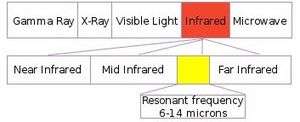Far infrared

Far infrared (FIR) is a region in the infrared spectrum of electromagnetic radiation. Far infrared is often defined as any radiation with a wavelength of 15 micrometers (µm) to 1 mm (corresponding to a range of about 20 THz to 300 GHz), which places far infrared radiation within the CIE IR-B and IR-C bands.[1] Different sources use different boundaries for the far infrared spectrum; for example, astronomers sometimes define far infrared as wavelengths between 25 µm and 350 µm.[2]
Visible light includes radiation with wavelengths between 400 nm and 700 nm, meaning that far infrared photons have less energy than visible light photons.[3]
Applications
Astronomy
Objects with temperatures between about 5 K and 340 K will emit radiation in the far infrared range (see Wien's displacement law and Black-body radiation). This property is sometimes used to observe interstellar gases where new stars are often formed.
For example, the center of the Milky Way Galaxy is very bright in far infrared images because the dense concentration of stars there heats the surrounding dust and causes it to emit radiation in this part of the spectrum. Disregarding the center of our own galaxy, the brightest far infrared object in the sky is the galaxy M82, which radiates as much far infrared light from its central region as all of the stars in the Milky Way combined. This is due to the dust at the center of M82 being heated by an unknown source.[2]
Longwave infrared heaters
As of 2015, recently developed electric or hydronic panel-based longwave infrared heaters are becoming more adopted.[4]
Human Body Detection
Some human proximity sensors use passive infrared sensing in the far infrared wavelength to detect both static[5] and/or moving human bodies.[6]
Therapeutic Modality
The infrared radiation (IR) band covers the wavelength range of 700 nm – 1 mm, frequency range of 430 THz – 300 GHz, and photon energy range of 1.24 meV – 1.7 eV. Far-infrared radiation (FIR) is found on the wavelength spectrum at 15–1000 µm with a frequency range of 0.3–20 THz, and photon energy range of 1.2–83 meV. In these IR radiation bands, researchers have noted that the far-infrared radiation band "transfers energy purely in the form of heat which can be perceived by the thermoreceptors in human skin as radiant heat." [7] They report that this radiant heat can penetrate up to 1.5 inches (almost 4 cm) beneath the skin. Biomedical researchers have experimented with the use of FIR emitting ceramics which are embedded into various fibers and woven into the fabric of garments. These researchers noted in subjects a "delay" in the "onset of fatigue induced by muscle contractions." [8] They propose that this ceramic-emitted FIR (cFIR) has the potential to promote cell repair. The American athletic apparel company, Under Armour, Inc, announced recently a line of athletic recovery sleepware which incorporates this technology.[9]
References
- ↑ Byrnes, James (2009). Unexploded Ordnance Detection and Mitigation. Springer. pp. 21–22. ISBN 978-1-4020-9252-7.
- 1 2 "Near, Mid and Far-Infrared". Caltech Infrared Processing and Analysis Center. Retrieved 2013-01-28.
- ↑ Gregory Hallock Smith (2006), Camera lenses: from box camera to digital, SPIE Press, p. 4, ISBN 978-0-8194-6093-6
- ↑ Radiant & Conductive Heating Systems
- ↑ "Mems Thermal Sensors". Omron Electronic Components Web. Omron. Retrieved 7 August 2015.
- ↑ "Pyroelectric Detectors & Sensors for Far Infrared, FIR (5.0 µm-15 µm)". Excelitas. Excelitas. Retrieved 7 August 2015.
- ↑ Vatansever, Fatma and Michael R. Hamblin. Far infrared radiation (FIR): its biological effects and medical applications. Photonics Lasers Med. 2012 Nov 1; 4: 255–266.
- ↑ Leung TK, Lee CM, Tsai SY, Chen YC, Chao JS. A pilot study of ceramic powder far-infrared ray irradiation (cFIR) on physiology: observation of cell cultures and amphibian skeletal muscle. Chin J Physiol. 2011;54(4):247–54.
- ↑ http://mashable.com/2017/01/06/under-armour-pajamas/
External links
| Library resources about Far infrared |